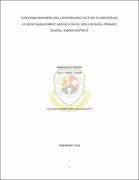Exploring barriers and contributing factors to menstrual hygiene management among school girls in rural primary schools: Kiboga District
Abstract
In spite of the vast studies on menstruation that have majorly focused on cultural influences and misconceptions as well as poor educational outcome due to mismanagement, there is lack of formative evidence on systems, structures and processes that present as obstacles to the hygienic management of menstruation in rural primary schools in Kiboga district. In this study, school environments both the social and physical have been found to be discriminatory in nature making it extremely difficult for girls to manage their menses. The problem is further confounded by lack of comprehensive accurate information, resources and facilities for effective menstrual hygiene management.
This has prompted the exploration of barriers of menstrual hygiene management, their propagating factors and overall impact on school aged adolescent girls. The outcomes are intended to inform district leadership and the entire rural communities on the importance of supporting schools to create positive enabling environments the are hygienic, safe, and private for girls to manage their menses with dignity.
In this qualitative exploratory study with a narrative strategic approach to inquiry, data collection has been characterized with in-depth unstructured interviews. The units of study and participants have been purposively selected with a primary focus on menstruating girls aged 13 to 14 years. Qualitative data collection methods and instruments have been used to collect data across the cascades of the ecological model. Group discussions and interviews have generated data that has been thematically analyzed to identify themes central to the phenomenon of menstrual hygiene management hence forming the categories of analysis for the study.
Among the current practices identified; school management committees together with the parents’ teachers’ associations do not consider menstrual hygiene matters on their agendas, school health programs meant to foster health regulations at school were non-existence. As much as school systems have a designated structure among their staff of a senior woman teacher as point of reference when girls seek for assistance in case of menstrual emergencies, they are not supported neither do they have guidance of a policy on how to proceed with menstrual management in school settings. These are some of the glaring gaps that this study was able to identify and hence their impact on the girls stay in school.
In conclusion, school aged adolescent girls in low resource settings lack adequate preparations when they begin their menses. They are limited to access of information, products, and infrastructure hence compromising their comfortability in school. This places them in a vulnerable positions affecting their self-esteem and confidence in school. Recommendations are drawn to attract social responsibility at all levels including civil society organizations to ensure that the psycho-social and physical barriers affecting menstrual hygiene management in schools are addressed. Furthermore, there is need to design policies and create practices that will support school systems in provision of long term solutions to a problem that has dragged for so long.


